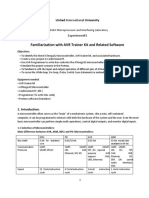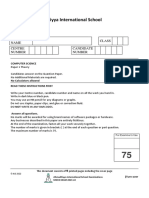The AVR Microcontroller: History and Features
The AVR Microcontroller: History and Features
Uploaded by
Azka GhaffarCopyright:
Available Formats
The AVR Microcontroller: History and Features
The AVR Microcontroller: History and Features
Uploaded by
Azka GhaffarOriginal Title
Copyright
Available Formats
Share this document
Did you find this document useful?
Is this content inappropriate?
Copyright:
Available Formats
The AVR Microcontroller: History and Features
The AVR Microcontroller: History and Features
Uploaded by
Azka GhaffarCopyright:
Available Formats
The AVR Microcontroller:
History and
Features
???
Microprocessors (CPU) vs Microcontrollers
(MCU) ???
CPU vs. MCU
Microprocessor
No RAM, ROM, I/O Ports on chip itself
e.g. Pentium (Intel), PowerPC (Motorola), Spark (SUN)
Applications: Desktop, Laptop, workstations, Servers
Microcontroller
Microprocessor, RAM, ROM, timers, I/O Ports on a single
chip.
8051(Intel), 68HC08 (Motorola), AVR (Atmel), Z8 (Zilog),
PIC (Microchip), ARM (Advanced RISC Machine).
Application: TV Remote Control, video games, robots,
CPU vs. MCU
Most common MCU/CPU
8-bit MCU
16-bit MCU/CPU
AVR
PIC
8051
8086/186/96/196
68HC12/16
32-bit MCU
ARM
PIC32
8-bit Microcontrollers
???
Embedded Systems ???
Embedded Systems
An embedded system is controlled by its own
internal microprocessor (or microcontroller)
as opposed to an external controller.
A PC is connected to various embedded
products such as keyboard, printer, modem,
disk controller, sound card, CD-ROM driver,
mouse and so on.
a printer gets data and prints it. A mouse
takes coordinates and sends to the PC.
Embedded Products
Computing
PC
Notebook
Laptop
Storage
Color printer
Laser printer
Modem
Cable modem
Copier
Scanner
Digital camera
Cars
Anti-lock breaks
Air bags
Engine Control
Transmission
Control
Climate control
Collusion
avoidance
Navigation
Trip Computer
Instrumentation
Keyless entry
Communications
Wire-line
Phone
Cellular
Phones
PDA
Pager
Fax machine
Intercom
Cards
Banking
Electronic
Purse
Social Security
Tolls
Embedded Products
Consumer
VCR, CD
Video games
DVD Player
Stereo
Smoke alarm
Camera
Remote Control
Garage Door
Opener
Security System
Consumer
Toys
Answering
machine
Camcorder
Musical
Instruments
Sewing
Machine
Exercise
equipment
Connectivity
Cable TV
Cable Modem
Router
Hub
Choosing a microcontroller
Speed: What is the highest speed a microcontroller
supports?
Packaging: Is it DIP (dual inline package) or a QFP
(quad flat package) or some other type?
Power Consumption: Critical for battery powered
products.
The amount of RAM and ROM on chip
The number of timers and I/O pins on chip
Cost per unite
Availability of Compiler, Simulator, Debugger.
Availability of chip in market
The AVR microcontroller
The basic architecture of AVR was designed
Family
by two students of Norwegian Institute of
Technology (NTH), Alf-Egil Bogen and
Vegard Wollan, and then was bought and
developed by Atmel in 1996.
The AVR stands for Advanced Virtual RISC,
or Alf and Vegard RISC.
The AVR is an 8-bit RISC single-chip
microcontroller with Harvard architecture.
RISC and CISC
CISC (Complex Instruction Set Computer)
A large number of instructions, typically from 100 to 250
instructions
Some instructions that perform specialized task and are used
infrequently
A large variety of addressing modes, typically from 5 to 20
different modes
Variable-length instruction formats
RISC (Reduced Instruction Set Computer)
Relatively few instructions
Relatively few addressing modes
Fixed-length, easily decoded instruction format
Harvard and von Neumann
Architecture
von Neumann (Princeton) architecture.
The same bus is used for accessing both the code and data
Pentium Processor is based on von Neumann Architecture
Harvard architecture
Separate buses are used for accessing the code and data
memory.
That means that we need four sets of buses:
1.
2.
3.
4.
A set of data buses for carrying data into and out of the CPU,
A set of address buses for accessing the data,
A set of data buses for carrying code into the CPU, and
An address bus for accessing the code
This is easy to implement inside an IC chip such as a
microcontroller where both ROM code and data RAM are
internal (on-chip) and distances are on the micron and millimeter
scale
The AVR microcontroller
Family
The Simplified view of an AVR Microcontroller
The AVR Family
The AVR can be classified into four groups: Classic, Mega, Tiny,
and special purpose.
Classic AVR (AT90Sxxxx)
This is the original AVR chip, which has been replaced by newer
AVR chips. These are not recommended for new designs.
Mega AVR (ATmegaxxxx)
These are powerful microcontrollers with more than 120
instructions and lots of different peripheral capabilities, which can
be used in different designs. Some of their characteristics are as
follows:
Program memory: 4K to 256K bytes
Package: 28 to 100 pins
Extensive peripheral set
Extended instruction set: They have rich instruction sets.
The AVR Family
The AVR Family
Tiny AVR (ATtinyxxxx)
This group have less instructions and smaller packages in
comparison to mega family. You can design systems with low
costs and power consumptions using the Tiny AVRs. Some of
their characteristics are as follows:
Program memory: IK to 8K bytes
Package: 8 to 28 pins
Limited peripheral set
Limited instruction set: The instruction sets are limited. For example,
some of them do not have the multiply instruction.
Special purpose AVR
The ICs of this group can be considered as a subset of other
groups, but their special capabilities are made for designing
specific applications. Some of the special capabilities are: USB
controller, CAN controller, LCD controller, Zigbee, Ethernet
controller, FPGA, and advanced PWM.
The AVR Family
Embedded Systems
AVR different groups
Classic AVR
Mega
e.g. ATmega8, ATmega32, ATmega128
Tiny
e.g. AT90S2313, AT90S4433
e.g. ATtiny13, ATtiny25
Special Purpose AVR
e.g. AT90PWM216,AT90USB1287
AVR different groups
AVR different groups
AVR different groups
Lets get familiar with the
AVR part numbers
ATmega128
Atmel group
ATtiny44
Atmel
Tiny
group
Flash =4K
Flash
=128K
AT90S4433
Atmel Classi
c
group
Flash =4K
You might also like
- Online Job Portal Project DocumentationDocument99 pagesOnline Job Portal Project Documentationbandushri66% (101)
- ARM Notes For StudentsDocument24 pagesARM Notes For StudentsAkshit Sharma100% (1)
- PlayStation Architecture: Architecture of Consoles: A Practical Analysis, #6From EverandPlayStation Architecture: Architecture of Consoles: A Practical Analysis, #6No ratings yet
- AVRDocument104 pagesAVRPriya Gupta100% (1)
- Multithreading: The Java Thread ModelDocument15 pagesMultithreading: The Java Thread ModelMasterNo ratings yet
- Microprocessor System (3 + 1)Document15 pagesMicroprocessor System (3 + 1)noumanNo ratings yet
- AvrDocument7 pagesAvrsamarathishNo ratings yet
- Atmel AVRDocument17 pagesAtmel AVRrudy_tanagaNo ratings yet
- Chapter 1Document20 pagesChapter 1Rekha PawarNo ratings yet
- Basic Families: Tinyavr - TheDocument2 pagesBasic Families: Tinyavr - TheVinoth KannanNo ratings yet
- Microcontroller History and FeaturesDocument28 pagesMicrocontroller History and FeaturesDaniel HernándezNo ratings yet
- AVR MicrocontrollersDocument38 pagesAVR Microcontrollerspaku deyNo ratings yet
- Ee443 L04 McuhwDocument24 pagesEe443 L04 McuhwAyberk Furkan YağdıNo ratings yet
- Introduction To AVR Microcontrollers: College of EngineeringDocument33 pagesIntroduction To AVR Microcontrollers: College of EngineeringAbdulla AshoorNo ratings yet
- General Introduction of ArmDocument21 pagesGeneral Introduction of ArmUPANSHU DAS 19BCI0129No ratings yet
- Popular Microcontroller and Their SelectionDocument7 pagesPopular Microcontroller and Their SelectionLachitNo ratings yet
- es_arduino_2Document29 pageses_arduino_2Quốc Đông VũNo ratings yet
- Familiarization With AVR Trainer Kit and Related Software: United International UniversityDocument18 pagesFamiliarization With AVR Trainer Kit and Related Software: United International UniversityNura Alam ProtikNo ratings yet
- 1 AVR IntroductionDocument20 pages1 AVR Introductionsalman_azmat_666No ratings yet
- Embedded Microcontrollers: Abebaw.ZDocument76 pagesEmbedded Microcontrollers: Abebaw.ZTamiru DerejeNo ratings yet
- ArchitectureDocument30 pagesArchitectureaayush kumarNo ratings yet
- Microcontroller Basics - PPSXDocument44 pagesMicrocontroller Basics - PPSXholaNo ratings yet
- Arm ArchitectureDocument63 pagesArm ArchitecturesrikanthpunNo ratings yet
- ARM7 - LPC 2148 ProcessorDocument50 pagesARM7 - LPC 2148 ProcessorHong ShaeNo ratings yet
- AVR Microcontroller SystemDocument37 pagesAVR Microcontroller SystemJohn LeungNo ratings yet
- Microprocessor UpdatedDocument202 pagesMicroprocessor UpdatedMuhammadShazaibNo ratings yet
- Microprocessor Systems Week 1 Unit 1: Introduction To Microprocessors and Microcontrollers I. Learner ObjectivesDocument6 pagesMicroprocessor Systems Week 1 Unit 1: Introduction To Microprocessors and Microcontrollers I. Learner Objectivessasmeetsharma12345No ratings yet
- ARM Processor: Computer Families-ARM, AVRDocument4 pagesARM Processor: Computer Families-ARM, AVRbroccoli singhNo ratings yet
- Week 02Document55 pagesWeek 02aroosa naheedNo ratings yet
- What Is Processor ?Document8 pagesWhat Is Processor ?Arya SinghNo ratings yet
- Embedded Systems BY Varisa Sasibhushanarao (PH.D) Assistant Professor, Department OF Electronics and Communication Engineering, Rajiv Gandhi University of Knowledge Technologies - SrikakulamDocument34 pagesEmbedded Systems BY Varisa Sasibhushanarao (PH.D) Assistant Professor, Department OF Electronics and Communication Engineering, Rajiv Gandhi University of Knowledge Technologies - SrikakulamPandu KNo ratings yet
- Higher MicrocontrollersDocument24 pagesHigher MicrocontrollersSwati JaswalNo ratings yet
- 722.file Ref.811.1632Document38 pages722.file Ref.811.1632Razdrizal Rizki ErmahriNo ratings yet
- AVR: Which Microcontroller To Choose: PIC VsDocument17 pagesAVR: Which Microcontroller To Choose: PIC VsMuhammad Zawar100% (1)
- Atmel AVRDocument13 pagesAtmel AVRAnonymous E4Rbo2sNo ratings yet
- Microcontroller:: Chapter-8: MicrocontrollersDocument20 pagesMicrocontroller:: Chapter-8: MicrocontrollersMd Raton AliNo ratings yet
- AVR Lecture 1Document22 pagesAVR Lecture 1معتز العجيليNo ratings yet
- Introduction To Arm ProcessorDocument10 pagesIntroduction To Arm Processorkeerthidhoni100% (1)
- Unit - Viii The AVR RISC Microcontroller's ArchitectureDocument9 pagesUnit - Viii The AVR RISC Microcontroller's ArchitectureTechnoGateKhammamNo ratings yet
- AVR Microcontrollers - Guide To Learning The Microcontroller Embedded SystemDocument13 pagesAVR Microcontrollers - Guide To Learning The Microcontroller Embedded Systemloopinversion100% (2)
- Notes - ESD - ARM Architecture RevisedDocument15 pagesNotes - ESD - ARM Architecture RevisedHiren TrivediNo ratings yet
- PicDocument71 pagesPicSanthosh SachithananthamNo ratings yet
- 18CS44 Module1Document46 pages18CS44 Module1SharanKumarHuliNo ratings yet
- Basic Concepts of The Personal ComputerDocument48 pagesBasic Concepts of The Personal ComputerpfalencarNo ratings yet
- ATMega8 UcDocument40 pagesATMega8 UcnrjchopraNo ratings yet
- Micro Controller AssignmentDocument10 pagesMicro Controller Assignmentramjee26No ratings yet
- Chapter 1 Introduction To Microcontrollers - 2023Document64 pagesChapter 1 Introduction To Microcontrollers - 2023trucdo0411No ratings yet
- Alama Activity#3Document6 pagesAlama Activity#3cruzxander680No ratings yet
- Lecture 02 - Microcontroller Core Features and ArchitectureDocument12 pagesLecture 02 - Microcontroller Core Features and ArchitectureAwaisNo ratings yet
- Avr Atmega 8 Uc: Lets Learn Fundamentals !!Document40 pagesAvr Atmega 8 Uc: Lets Learn Fundamentals !!malhiavtarsinghNo ratings yet
- ARM ComparisonsDocument6 pagesARM ComparisonsJMNo ratings yet
- Module 1 - AVR v3 2022Document44 pagesModule 1 - AVR v3 2022JainamNo ratings yet
- Buses Buses Buses: Von Neumann Architecture: Von Neumann Architecture: Von Neumann ArchitectureDocument5 pagesBuses Buses Buses: Von Neumann Architecture: Von Neumann Architecture: Von Neumann ArchitectureShiuli BarmanNo ratings yet
- Fig. 1: Block Diagram Showing Architecture of AVR MicrocontrollerDocument30 pagesFig. 1: Block Diagram Showing Architecture of AVR MicrocontrollerPranav PrNo ratings yet
- All About MicrocontrollerDocument11 pagesAll About MicrocontrollernolawitNo ratings yet
- DRDODocument21 pagesDRDOAyush AgarwalNo ratings yet
- AssDocument9 pagesAssJane SalvanNo ratings yet
- Difference Between AVR, ARM, 8051 and PIC MicrocontrollersDocument9 pagesDifference Between AVR, ARM, 8051 and PIC MicrocontrollersAhmad fauzi ihsanNo ratings yet
- Department of Electronics & Instrumentation: Question Bank: CS 2361 EMBEDDED SYSTEMDocument8 pagesDepartment of Electronics & Instrumentation: Question Bank: CS 2361 EMBEDDED SYSTEMBarkavi CharuNo ratings yet
- Avr Trainer Cara Buat Progam Dengan AvrDocument3 pagesAvr Trainer Cara Buat Progam Dengan AvrMuh Iwan TaufikNo ratings yet
- MicrocontrollerDocument25 pagesMicrocontrolleryuriNo ratings yet
- Tait Private LTE Solutions ENodeB BrochureDocument12 pagesTait Private LTE Solutions ENodeB BrochureIon GratiNo ratings yet
- Application IDDocument52 pagesApplication IDathulyabeenaraniNo ratings yet
- Installing Wordpress Blog Using Apache On EC2 LinuxDocument17 pagesInstalling Wordpress Blog Using Apache On EC2 LinuxUbaid SaadNo ratings yet
- Mock p1 Ais Comp Sci Cie IgcseDocument9 pagesMock p1 Ais Comp Sci Cie IgcseAala SolihNo ratings yet
- Unit 2: MCQS: Sr. No. Questions Option - A Option - B Option - C Option - D Correct AnswerDocument8 pagesUnit 2: MCQS: Sr. No. Questions Option - A Option - B Option - C Option - D Correct AnswerPriyansh GanganiNo ratings yet
- ABB ACS850 ACSM1 FENA 01 Ethernet ManualDocument52 pagesABB ACS850 ACSM1 FENA 01 Ethernet ManualVu TuongNo ratings yet
- Unit-I Python NotesDocument62 pagesUnit-I Python NotesRameshPrasadBhattaNo ratings yet
- Schools Division of Zamboanga Del Norte Polanco National High SchoolDocument4 pagesSchools Division of Zamboanga Del Norte Polanco National High SchoolrosellerNo ratings yet
- Windows Cannot Access The Specified Device or File PathDocument12 pagesWindows Cannot Access The Specified Device or File PathPaul KatemaNo ratings yet
- ML-Based Radio Resource Management in 5G and Beyond Networks A SurveyDocument22 pagesML-Based Radio Resource Management in 5G and Beyond Networks A SurveyweromNo ratings yet
- Dot NetDocument12 pagesDot NetPriya MauryaNo ratings yet
- Robotics in Our Everyday LivesDocument4 pagesRobotics in Our Everyday LivesArni VoraNo ratings yet
- Security Enhancement in Data Propagation For Wireless NetworkDocument10 pagesSecurity Enhancement in Data Propagation For Wireless NetworkZainlab UddinNo ratings yet
- 1 Time Lower Bound For PalindromesDocument2 pages1 Time Lower Bound For PalindromesNikhil SabuNo ratings yet
- CAO ReportDocument17 pagesCAO ReportAditi PawseNo ratings yet
- AU & NZ Outlets - & - Switches - SpecificationsDocument6 pagesAU & NZ Outlets - & - Switches - SpecificationsDanilo FonzareNo ratings yet
- HCNA Training Course OutlineDocument2 pagesHCNA Training Course OutlineZawhtet HtetNo ratings yet
- 201 Python ProgrammingDocument189 pages201 Python Programmingpaeg6512No ratings yet
- The Most Widely Used Agile ProcessDocument3 pagesThe Most Widely Used Agile ProcessMuhammad AhmadNo ratings yet
- Cisco Powervu Network Center Data Backup/Restore (Pncbmenu) User GuideDocument22 pagesCisco Powervu Network Center Data Backup/Restore (Pncbmenu) User Guideandlee74No ratings yet
- Faculty of Inforamation Technology and Communication Studies. Department of Information Technology Studies LEVEL 200Document33 pagesFaculty of Inforamation Technology and Communication Studies. Department of Information Technology Studies LEVEL 200Bra Kofi TheophilusNo ratings yet
- Axxonsoft Performance and ValidationDocument13 pagesAxxonsoft Performance and ValidationRidwan OnoNo ratings yet
- NLP Unleashed Transforming Communication & InsightsDocument12 pagesNLP Unleashed Transforming Communication & Insightsdrn86686No ratings yet
- CSC 421 OOP JavaScript Is Client and OBJECT ORIENTED PROGRAMMINGDocument27 pagesCSC 421 OOP JavaScript Is Client and OBJECT ORIENTED PROGRAMMINGdaily feastNo ratings yet
- Stored Program Computer Concept Q2 ElectronicsDocument5 pagesStored Program Computer Concept Q2 ElectronicsApril EspiñaNo ratings yet
- Croma Campus - Microsoft D365 Business Central Training With AL Vs CodeDocument5 pagesCroma Campus - Microsoft D365 Business Central Training With AL Vs CodeTapas GhoshNo ratings yet
- Communication User's Manual (OPC-UA) (B)Document50 pagesCommunication User's Manual (OPC-UA) (B)Thành Hậu ĐặngNo ratings yet
- Guia de C#Document2,358 pagesGuia de C#Jhonathan Miranda100% (1)

























































































